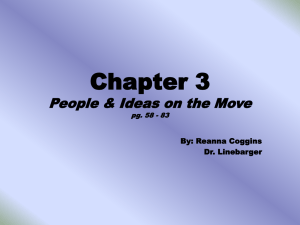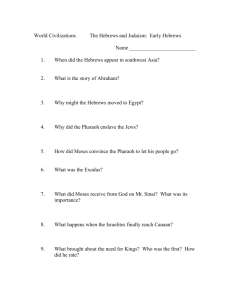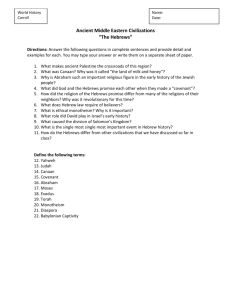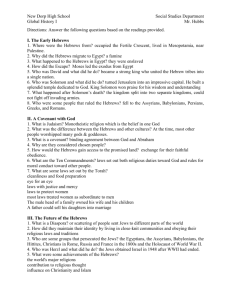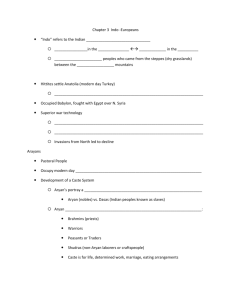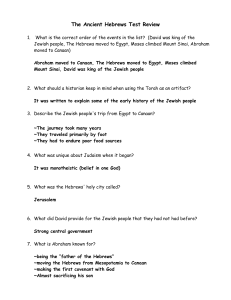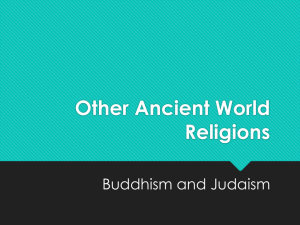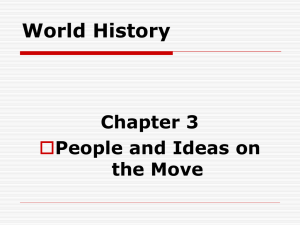File
advertisement
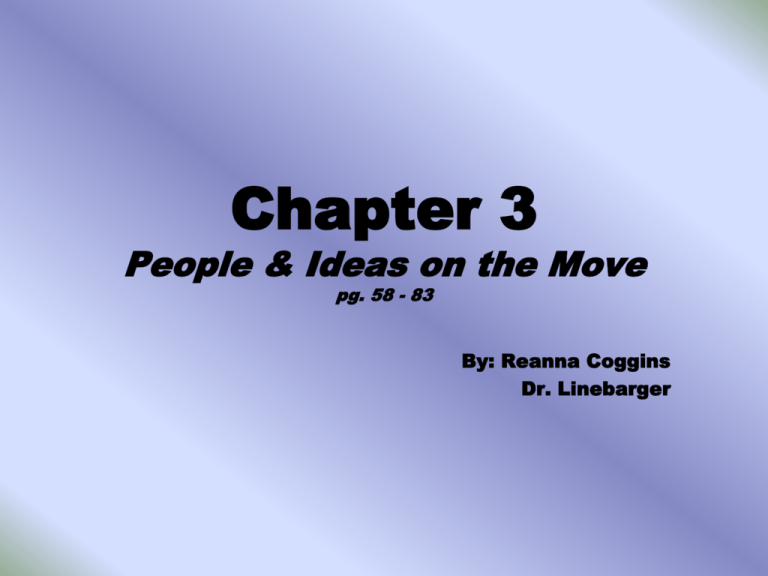
Chapter 3 People & Ideas on the Move pg. 58 - 83 By: Reanna Coggins Dr. Linebarger Table of Contents • • • Section 1 – The Indo- Europeans -Geography, agriculture, & way of life -Spread & Influence of Indo- Europeans -Unexplained Migration -The Hittite Empire -Hittites adapt new ideas -Chariots & iron technology -The Aryans -Caste System -Aryan kingdoms expand Section 2 – Hinduism & Buddhism develop -Hinduism -Buddhism -Buddhist beliefs Section 3 – Seafaring Trading -Minoans -Minoan Civilization ends -Phoenicians -Phoenician Alphabet -Ancient trade route Section 4 – The Origins of Judaism -Palestine & Canaan -The Torah -Abraham -Their God -Arrival to Egypt -Moses -The Ten Commandments -A New Life -Saul & David -Solomon -The kingdom divides -Assyrian tribute -Babylon takes control -Citations Section 1 The Indo-Europeans Indo-Europeans: geography, agriculture, & way of life • Indo-Europeans were nomadic people that came from steppes north on the Caucasus. • Herded cattle, sheep, & goats. • Tamed horses & rode into battle in light, two wheeled chariots. • Lived in tribes that spoke forms of language that we now called Indo-European. Spread & Influence of Indo-European language • The Indo-European language is the ancestor of modern languages in Europe. • English, Spanish, Persian, German, & Hindi trace their origins to Indo-European language. • Historians can tell where Indo-European tribes settled by their language -Slavic- north & west -Celtic, Germanic, & Italian- west through Europe -Greek & Persian- south -Sanskrit- India Unexplained Migration • No one knows why the Indo-European left their homeland in the steppes. • Migrated outward in all directions between 1700 & 1200B.C. • Migrations happened over a long period of time The Hittite Empire • Occupied Anatolia also called Asia Minor Anatolia - big peninsula in modern day Turkey. - high, rocky plateau, rich in timber & agriculture. - mountains nearby hold important mineral deposits. • Separate city-states came together to form an empire in 1650 B.C. • Dominated Southwest Asia for 450 years. • Argued with Egypt for control of Syria -> neither won -> both signed a peace treaty pledging to help each other fight future invaders Hittites adopt new ideas • Used Indo-European language with one another • For international use, they adopted Akkadian. • Borrowed ideas about literature, art, politics, & law from Mesopotamians. Chariots & Iron technology • • • • Hittites won many wars through their superior chariots & iron weapons. Around 1500 B.C., the Hittites were the 1st in southwest Asia to work with iron & harden it into weapons of war. The raw materials they needed ( iron, ore,& wood) were easily available in the Anatolia mountains. Hittite empire fell suddenly in 1190 B.C. because of attacks from tribes from the north. Pulled by 2 horses Wooden frame Two wheels The Aryans • • The Aryans homeland was probably between the Caspian & Aral sea, or in India They left their sacred literature, the Vedas, which showed a picture of Aryan life. - the Vedas are four collections of prayer, magical spells, & instructions for performing rituals - most important part was the Rig Veda, which contains 1028 hymns. Vedas texts Caste System • • • • When the Aryans first arrived in India, they were organized into 4 groups based on their occupation. - Brahmins (priests) - warriors - traders & landowners - peasants In the 15th century explorers from Portugal encountered this social system & called it the castes. Aryans caste membership determined the work they did, whom they could marry, and whom they could eat with. Cleanliness was also important. People such as butchers, grave diggers, or trash collectors lived outside the caste system, and became known as “untouchables”. Aryan kingdoms expand • Over time, Aryans extended settlement east, along the Ganges & Yamuna river valleys. • • At first, chiefs were elected by the whole tribe. • Around 1000B.C. a minor king, Magadha, began to emerge. • In the 6th century B.C., Magadha began expanding their territory. By the 2nd century B.C., Magadha had expanded south to occupy most of India. • Mahabharata, one of the great epics from India reflects the struggles that took place in India as the Aryan kings worked to control Indian lands. Section 2 Hinduism & Buddhism develop Hinduism • • • • • Moksha is a state of perfect understanding of al things. When a person understands the relationship between atman and Brahman, that person achieves perfect understanding (moksha) and a release from life in this world. Through a process called reincarnation, a person’s soul or spirit is born again and again until moksha is achieved. Karma is a soul’s good or bad deeds. If a person is born as a Brahman, warrior, or merchant, his fortune came from good karma earned in their former life. However if a person is born as a female, a laborer, or an untouchable, they would be getting bad karma from their former life. Hindus believe Brahman, the world soul, had the personalities of three gods: Brahma, the creator; Vishnu, the protector; and Shiva, the destroyer. Over time, Brahman faded into the background while Devi, the great Mother Goddess, grew important. Buddhism • Buddhism was founded by Siddhartha Gautama. • After venturing outside the palace many times, Siddhartha, at age, 29, decided to spend the rest of his life searching for religious truth and an end to life’s suffering. Siddhartha spent 6 years wandering the forest in India, seeking enlightenment. • He tried many methods, yet non of them worked. One day he sat in meditation under a fig tree. After 49 days of meditation, he finally found his answer. • From then on he was called Budha. He preached his first sermon to his five companions. Buddhist beliefs • Buddhists believe in the Four Noble Truths. • • The eight-fold path is a guide to behavior. By following the Eighth-fold path, anyone could reach nirvana, release from selfishness and pain. Buddhists also believe in reincarnation. Buddhism Spreads • Monks & nuns wandered throughout India spreading the Buddha’s words. • Teachings of Buddha were written shortly after Buddha’s death. • Centuries after Buddha died missionaries were able to spread his faith over large parts of Asia. • As important as missionaries were to the spread of Buddhism, traders played an even more crucial role in this process. Along with goods, traders carried Buddhism beyond India to Sri Lanka. • Buddhism was also brought southeast along trade routes to Burma, Thailand, and the island of Sumatra. • Buddhism also spread to the Silk Roads in China. From China to Korea to Japan. Section 3 Seafaring Trade Minoans • The Minoans were powerful seafaring people who dominated trade in eastern Mediterranean from 2000 to 1400 B.C. • Lived in Crete on the southern edge of the Aegean Sea • Traded pottery, swords, figurines, & precious metals. Also exported art & culture ( unique architecture, burial customs, & religious rituals). • Knossos was the Minoan capital city. • Minoans were known as grateful, athletic people who enjoyed boxing, wrestling, & bull leaping. • Women held a higher rank than males. Minoan Civilization Ends • Minoan civilization ended around 1200B.C. • Although the reasons are unclear, historians believe that it was because of a series of natural disasters ( many earthquakes, volcanic eruption, & a tidal wave) in 1470B.C. • The Minoans never recovered from the last attack. • But somehow, they managed to stick around for 300 more years. • After that invaders from Greece took advantage of their weakened condition & destroyed them. Phoenicians • • • • • • • About 1100B.C., the most powerful traders along the Mediterranean were the Phoenicians. They founded a number of wealthy city-states such as Byblos, Tyre, & Sidon, which became important trading centers. Known as remarkable shipbuilders & seafarers. They ventured out to some places such as the Straight of Gibraltar, Britain, & around the continent of Africa. Traded such goods as wine, weapons, precious metals, ivory, & slaves They were also good crafts people who worked with wood, metal, glass, & ivory. Phoenicians built colonies along the northern coast of Africa and the coasts of Sicily, Sardinia, & Spain. They were about 30 miles apart. Phoenician Alphabet • • • • Because Phoenicians were merchants, they needed a way of recording transactions quickly & clearly. So they developed a writing system that used symbols to represent sounds. The word “alphabet” comes from two letters in the Phoenician alphabet: alph & beth Greeks adopted to Phoenicia’s alphabet. Phoenicians made a major contribution to the world by making a simplified alphabet, which made learning accessible to many people. Ancient Trade Routes • Trade connected the Mediterranean Sea with other parts of the world such as South & East Asia. • Trade routes also connected the Arabian Sea to the Persian Gulf & the Red Sea. Traders could go to Egypt & Syria. • To cross the Arabian Sea sailors used monsoon winds which blew southwest during the hot months & northeast during the cold season. Section 4 The Origins of Judaism Palestine and Canaan • Palestine’s location was cultural crossroads of the ancient world. • By land, it connects two great empires: Africa and Asia. • Assyria and Babylonia lay to the west, and Egypt to the east. • Seaports opened onto the two most important waterways of that time: the Mediterranean and the Red Sea. • Hebrews settled in Canaan which lay between the Jordon River and the Mediterranean Sea. • Canaan was the land God had promised to Jews, according to the Bible. The Torah • Jews holy book is called the Torah. • Recounts origins of humanity & Judaism. • It contains the basic laws of Judaism. • Early history of Jews can be found in the first five books of the Torah. Abraham • In the Torah, God chose Abraham to be the “father” of the Hebrew people. • Abraham was a shepherd who lived in the city of Ur, in Mesopotamia. • God commanded him to move his people to Canaan saying,…“Go from your country and your kindred and your father’s house to the land that I will show you. I will make of you a great nation, and I will bless you, and make your name great.” Genesis 12 Abraham’s Journey • Abraham and his family roamed for many years from Mesopotamia to Canaan to Egypt and back to Canaan. Their God • Unlike other groups around them, Hebrews practiced monotheism, meaning a belief in a single god. • The name of their god was Yahweh. • To Hebrews, Yahweh was the one and only god, and had power over all peoples. • Yahweh looked after the Hebrews not because of sacrifices and rituals, but because Abraham had promised to obey him. • In return, Yahweh had promised to protect Abraham and his descendants. This mutual promise is called a covenant. Arrival in Egypt • Hebrews migrated to Egypt because of a drought and threat of a famine between 1300 & 1200 B.C. • When they first got there, Hebrews were given places of honor in the Egyptian Kingdom. • Later they were forced into slavery. Moses • The Torah says that the man who led the Hebrews out of slavery was named Moses. - During the time of Moses’ birth, the Egyptian king felt threatened by the number of Hebrews in Egypt, thus ordering al male babies to be killed. Moses’ mother, Jochebed, hid her baby in the reeds along the banks of the Nile. An Egyptian princess then found and adopted him. Though raised in luxury, he did not forget his Hebrew birth. When God commanded him to lead the Jews out of Egypt, he obeyed. The Ten Commandments • • • • While the Hebrews were traveling across the Sinai Peninsula, Moses climbed to the top of Mount Sinai to talk to God. When he came down from the mountain, he brought down two stone tablets on which Yahweh had written the Ten Commandments. The Ten Commandments became the basis for the civil and religious laws of Judaism. Hebrews believed that this was anew covenant. God promised to protect the Hebrews while they promised to keep God’s commandments. A New Life • The Hebrews wandered for 40 years in the Sinai Desert. • After Moses died, they returned to Canaan. • Hebrews made a change from nomadic, tribal society to settled herders, farmers and city dwellers. • When they arrived in Canaan, they were organized into 12 tribes which were self-governed. • God chose a series of judges, one of the most prominent of whom was a woman, Deborah. • Canaan had arid deserts, rocky wildernesses, grassy hills and hot dry valleys. • Water was not plentiful. • The Hebrews expanded south and north. Saul and David • • • • • • • • Chosen judges occasionally pulled together the scattered tribes for a united military force. The Hebrews got along with most of their Canaanite neighbors. One of the few against them was the Philistines who threatened the Hebrews position in ancient Palestine. Eventually, the 12 tribes became one big tribe of Judah. As a result, Hebrews came to be called Jews, hence Judaism. From 1020 to 922B.C., the Jews united under three kings: Saul, David and Solomon. The new kingdom was called Israel. The first to rule was Saul. He was portrayed as a tragic man who was given to bouts of jealousy. After his death, his son-in-law, David, came into power. King David, an extremely popular leader, united the tribes, established Jerusalem as the capital and founded a dynasty. Solomon • In 962B.C. David was succeeded by his son Solomon, whose mother was Bathsheba. • Solomon was the most powerful of the Hebrew kings. • He built a trading empire and beautified Jerusalem. • Solomon also built a temple to glorify God. The temple became the permanent home for the Ark of the Covenant, which contained the tablets of Moses’ law. • The temple had bronze pillars at the entrance , stone on the outside and cedar covered in gold on the inside. The main hall was richly decorated with brass & gold. The Kingdom Divides • Solomon’s building projects required high taxes, badly straining the kingdom’s finances. • In addition, men were forced to spend one month out of every three working on the temple. • The expense and forced labor caused much discontent. • After Solomon’s death, the Jews in the northern part of the kingdom revolted. • In 922 B.C., the kingdom divided in two: Israel to the north and Judah to the south. • For the next 200 years, Israel and Judah sometimes fought each other and at other times, joined together against outside enemies. Assyrian Tribute • In 738B.C., both Israel and Judah began paying tribute, peace money paid by a weaker power to a stronger one, to Assyria. • By paying tribute, Israel and Judah hoped that Assyria would not attack. • But the tribute was not enough and in 725B.C., the Assyrians began to attack Samaria, the capital of Israel. • By 722 B.C., the whole northern kingdom had fallen to the Assyrians attack. Babylon takes control • Judah resisted for 150 years before it too was destroyed. • After conquering Israel, the Assyrians rapidly lost power to the rising Babylonian empire. • The Babylonian king, Nebuchadnezzar, ran the Egyptians out of Syria and Palestine, and attacked Jerusalem twice. • The city fell in 586B.C. and Solomon’s temple was destroyed. • Fifty years later, in 539B.C., the Persian king, Cyrus the Great, conquered Babylon. • Cyrus ordered the rebuilding of Solomon’s temple. • The second temple was completed in 515B.C. Citations • www. arch.mcgill.ca • www.wiki.answers.com
